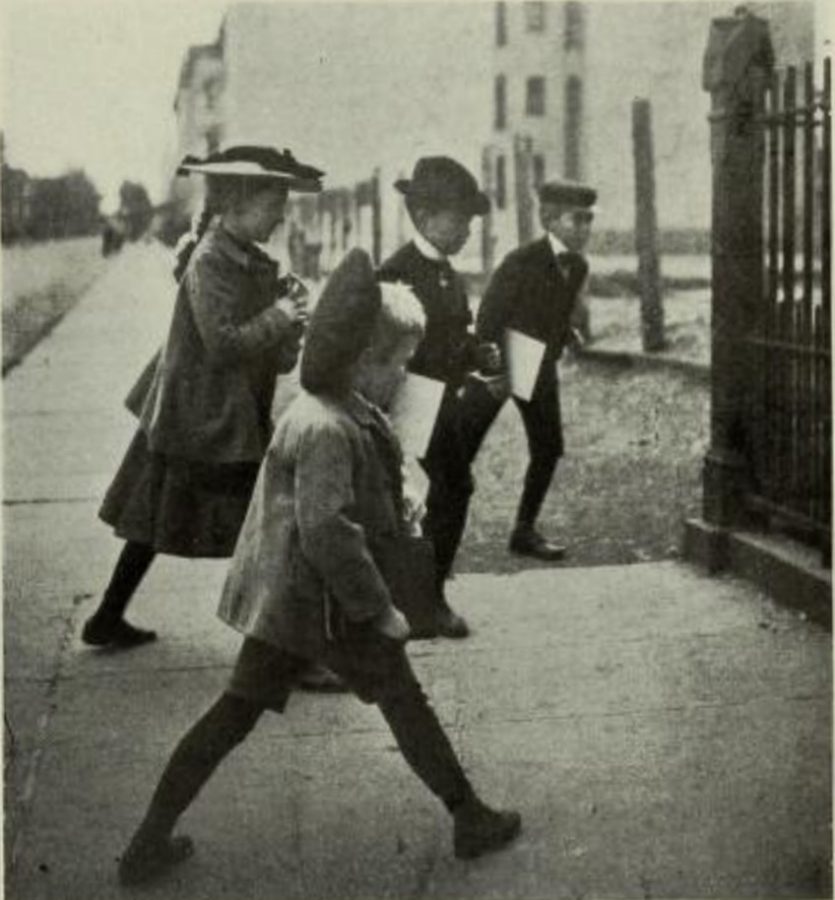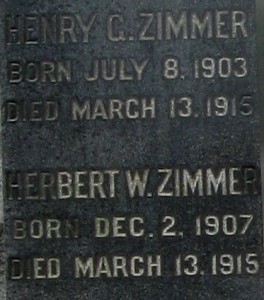Unseen For 115 Years – Photographs of New York City School Life & Kids

Children arriving late “A Minute After Nine” New York City schools September 1902 photo: Florence Maynard
Our previous story on Why People Disbelieve the Newspapers led to browsing other issues of World’s Work magazine.
Inside the covers are a treasure trove of interesting articles and photographs that generally have remained hidden since their original publication.
From the October 1902 World’s Work was “A Day’s Work in A New York Public School” by William McAndrew . There are some great photographs by Florence Maynard taken to accompany the article.
So what was a day’s work in a New York City public school like?
3,000 children were crowded into one typical school. 40 or more students in a class. Supplies were in short order. Free space to play was non-existent. Children of different intellect, culture and background were taught civics, patriotism and the 3 R’s. There was one language you were expected to learn- English.
But if you think the article has a negative take-away, you would be mistaken. McAndrew extols the schools, students, teachers, administrators, and the education system despite the shortcomings.
Look into the faces of these New York City schoolchildren of a century ago. What do you see?
Here are the photos with short excerpts from the article.
Three thousand throats do service to the cause of patriotism. Shrill little trebles, very new and fresh, basses not yet sure of the dignity of a changed register, besides all the voices between, unite to shout out the national anthem, or some other song required by law. The school rises to its feet. Every hand comes to the position of salute and then extends upward and outward towards the banner while the voices declare in unison: ” I pledge allegiance to my Flag.”

“Well-doers waiting for the principal’s commendation.” New York City schools September 1902 photo: Florence Maynard
A pretty morning ceremony is the procession of candidates to the office of the principal for daily commendation one or two children from each room, bearing their trophies of penmanship or ciphering with them. Each has his card of introduction, properly endorsed, accrediting him to the court of the Great Potentate. It reads:
To The Principal. Sept. 30, 1902.
This will introduce to you Johnny Johnson From Room 32 whom I recommend for compliment for great improvement in behaving himself.
Mary Potter
Teacher.

“The Geography Club cutting up illustrated magazines” New York City schools September 1902, photo: Florence Maynard
There is no limit to the benefits the public schools derives from private benefactions. Taxation can never supply enough income to permit the school authorities to equip the buildings as any generous lover of children would wish. To erect a safe, well-lighted structure, architecturally artistic, is the limit of the city’s ability. The inner walls must be bare. Casts and pictures, if they come at all, must be the gift of some intelligent citizens who recognize the subtle and silent teaching done by good art in the places where our children spend a good part of the most susceptible period of their lives.

“A ‘Playground’ – You musn’t run; you musn’t throw a ball; you musn’t make a noise.” New York City schools September 1902 photo: Florence Maynard
Perhaps still more beneficent to the future citizenship of our municipality is the gift of playgrounds. The recess of the average city school is a pitiful mockery of the natural desires of young America. He may not throw the ball : he might break a window. He may not run : he might knock some one over upon the hard pavement. It is well for him not to shout : the echoing walls of the court carry the noise into the class-rooms where his fellows are trying to recite. He must stand about with hands in his pockets and think black thoughts of rebellion : these youngsters, whose fathers have forgotten what boys require.

“Playing on private grounds prohibited.” New York City schools September 1902, photo: Florence Maynard
Half a block away is a great vacant plot with room to run and jump and a chance to halloo. Out of this, four times a day, the majesty of the law will chase him, until, hounded from lot to lot and street to street, he finds that everything official is against him and with all our devices for municipal conveniences we have no use for boys.
Children suspected of contagious disease are examined carefully and when their presence may endanger others they are excluded. Every day the Health Board sends to every school a printed list of all houses where contagious disease exists. The principal must compare the addresses with his register and exclude residents of the specified houses.
It is that formidable thing, the fire drill. Electric gongs sound their warning alarms. The youngsters prick up their ears expectantly. Five taps are heard. That means hats and coats. Another tap. The sound of a great tramping is heard. By the nearest stairways in double lines the three thousand silent soldiers, each on his very best behavior, march to the street and stand blinking in the bright sunlight, or with hair disheveled in the wind…
This article serves as a re-introduction to the talented Florence Maynard born in Chicago, Illinois, April 6,1867, the first of three children of Otis Riley Maynard and Minerva “Minnie” Bowen Maynard.
Florence Maynard was raised in Massachusetts and started her artistic career as a painter. Maynard was introduced to a 5 x 7 box camera when she worked as an assistant to another woman photographer in New York City. She became enamored with photography and pursued a career as a full-time photographer.
For landscape photography Maynard used a simple Kodak. Her specialty though was portraits. She became one of the premier indoor portrait photographers of the early 20th century, most often visiting the homes of her clients. With her younger brother Charles “Karl” Maynard (September 21 1874 – August 15, 1951), she opened up a studio in Philadelphia around 1910 and returned around 1916 to Massachusetts establishing a business in Newton. During the 1910s, her photographic work was featured in many photography magazines. She had one woman exhibitions and was highly praised by critics.
Her empathetic photos may because of her outlook on humanity. In a 1917 interview with the Christian Science Monitor, Maynard said, “And another thing that I am discovering and that is this: That everybody is really beautiful. I am coming to recognize this more and more. Persons who at first glance seem unattractive and uninteresting prove after half an hour’s acquaintance to be possessed of a real charm and beauty which it is a joy to reproduce with the camera. It was there all the time of course, and just needed to be uncovered. You seek to bring out the true character of each person and in doing this you are constantly making discoveries which by and by, convince you that everybody is beautiful.”
After a listing in the 1953 Newton, MA directory there is no trace of her or her work. According to the Massachusetts death index she died sometime in 1958. There is no obituary in newspapers that are available online and no one in her family has a listing at findagrave.com
As a pioneer woman photographer, she has been neglected and in turn forgotten. Hopefully more of Florence Maynard’s work will come to light due to this article.

















Hi,
Delightful look back at a forgotten time, very well written and researched– thanks for writing it!
I’m looking for information about PS 58 in Manhattan, on 52nd. St. west of 8th Ave. My grandfather grew up in Hell’s Kitchen, near 10th Ave. and W. 57th, in the 1910’s, and I believe he would have attended this school. He later attended DeWitt Clinton Boy’s High. I can find no information at all about PS 58, and assume it is long since gone, or moved to another location; but I’d love to know if the building is still there.
Do you have any resources I could look into about this? Thank you so much.
PS 58 was located at 317 West 52nd Street.
The original school was demolished after 1966.
It was replaced by The Manhattan School (Manhattan High School) and is now designated Public School 35 – see it here–
The original PS 58 can be seen here in two views from 1920 & 1929 respectively
view 1
and view 2
Hello, I am writing a research report on New York City schools in the early 1900s and am interested in where you got some of your sources for this post? Any help would be appreciated and thanks in advance!
I LOVED YOUR ARTICLE please feel free to google my name MARTIN RASKIN and read the MAY 19 2018 NEW YORK TIMES article “HE IS OLD SCHOOL AND HE HAS THE DUNCE CHAIR TO PROVE IT” and the MARCH 31 2010 NEW YORK TIMES article “AMASSING A SHRINE TO HIS OLD SCHOOL. i would love at some point to contact you thank u martin raskin
‘”
I attended PS 93 in Manhattan C1949 to 1952. I cannot find any reference at all to PS 93.
Any information will be appreciated.
That is probably because P.S. 93 moved into a new building on September 11, 1950, from their old location at 93rd Street and Amsterdam Avenue to their new location at West End Avenue between 95th and 96th Streets. P.S. 93 was then renumbered as P.S. 75 and retains that designation to this day. There is no school called P.S. 93 in Manhattan since that time.
I can’t find information about the original PS 93. Was it also a middle school or just elementary? Curious how you know so much about it! Thanks
To answer your first question – I’m not sure.
Second – How do I know so much about it? I don’t. I researched it and fact checked what I found.
Florence Maynard and her brother Karl, working as The Maynard Workshop, published hundreds of postcards of New England scenes. A collection is available for viewing on the Web at http://www.newtonma.gov/gov/historic/events/past/maynard/default.asp. That’s the Web site of the Newton History Museum — the Maynard’s lived in Waban, a village of Newton, MA.
Thank you for taking the time & effort to research and write this article. It clearly demonstrates that in the midst of this country’s immigration boom, patriotism and education were paramount! “Political correctness” and the liberal, progressive policies of NYC Mayor DeBlasio’s administration are killing education, and the future of the city’s children!
I know a couple of NYC Board of Ed teachers and they cannot wait to retire. The liberal, no-hope atmosphere, lack of parent participation and care, are many of the symptoms.
Thanks for writing in.